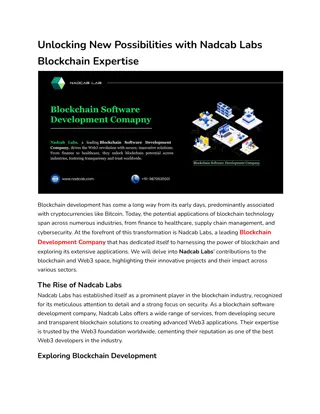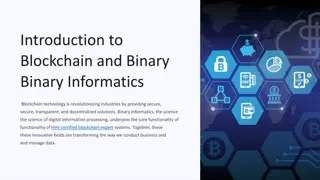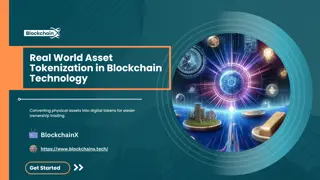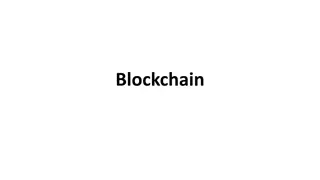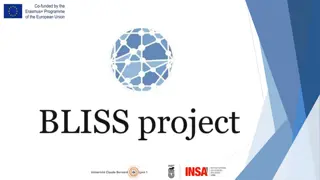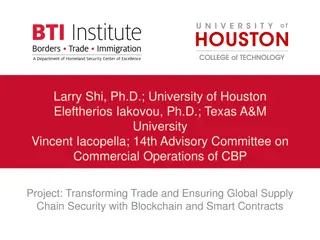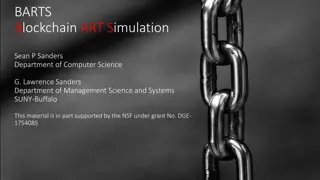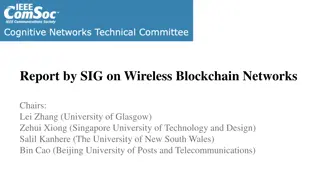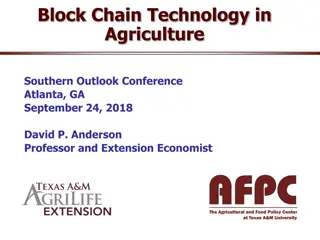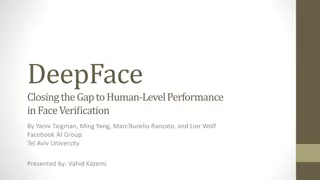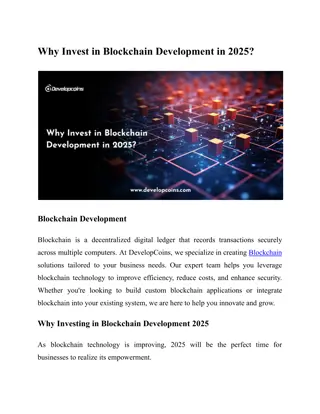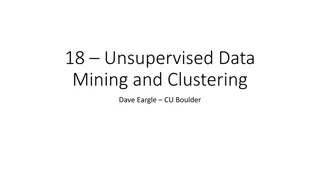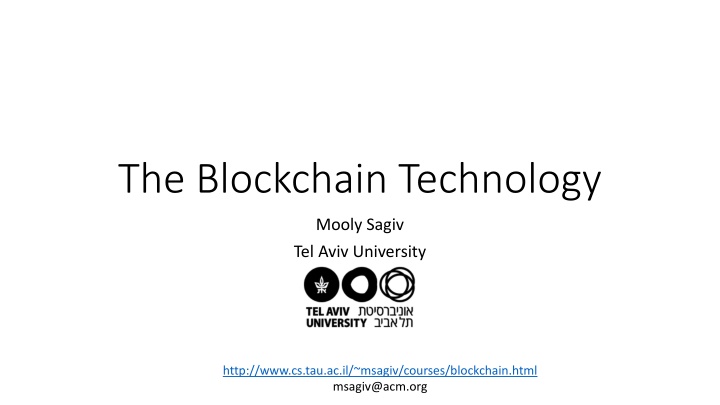
Exploring Blockchain Technology at Tel Aviv University
Delve into the world of blockchain technology through a comprehensive course at Tel Aviv University. Learn about the fundamentals, advisory board members, prerequisites, and the tentative schedule. Dive deep into concepts like traditional online transactions, distributed DBMS, and more.
Download Presentation

Please find below an Image/Link to download the presentation.
The content on the website is provided AS IS for your information and personal use only. It may not be sold, licensed, or shared on other websites without obtaining consent from the author. If you encounter any issues during the download, it is possible that the publisher has removed the file from their server.
You are allowed to download the files provided on this website for personal or commercial use, subject to the condition that they are used lawfully. All files are the property of their respective owners.
The content on the website is provided AS IS for your information and personal use only. It may not be sold, licensed, or shared on other websites without obtaining consent from the author.
E N D
Presentation Transcript
The Blockchain Technology Mooly Sagiv Tel Aviv University http://www.cs.tau.ac.il/~msagiv/courses/blockchain.html msagiv@acm.org
Advisory Board Shelly Grossman Noam Rinetzky Ittai Abraham Guy Golan-Gueta Yan Michalevsky Benny Pinkas Ittay Eyal Orr Tamir Eran Tromer
Outline Formalities Prerequisites Course Goals Course Requirements Tentative Schedule A gentle introduction A better one next week by Ittay Eyal (Tehnion) Guides to presentation (short)
Prerequisites Computational Models One of the following Logics in Computer Science Cryptography
Tentative Schedule March 4: Overview and Introduction March 11: Ittay Eyal, Technion: Basics of mining and incentives April 4: Ittai Abraham, Vmware and Hebrew University: The Bitcoin Blockchain and Nakamoto Consensus April 22: Yonathan Sompolisky, Hebrew University: TBD Presentations by Students
Seminar Goals Learn how to read a scientific article in computer science Not necessarily practical for Blockchain Not self contained Critical thinking >100 hours Learn how to prepare a high quality presentation Help from Instructor A lot of good advise in the Internet > 150 hours Read introductory material Meet the instructor twice (at least) Participate in 11 lectures
Traditional Online Transactions Trusted third party Yup! He sent the money $10,000 1. Validate entries 2. Safeguard entries 3. Preserve historic records
Questions Can we permanently store assets globally with trust? Single ownerships Identity management Easy transfer of assets Create the illusion of a single global computer
Distributed DBMS Distributed DBMS
Limitations of Distributed Databases Centralized Complexity & Costs Trust the database company
How Blockchain works? The block is broadcast to every node in the network A wants to send money to B The transaction is represented as block ? ? ? ? ? A The transaction is added to Blockchain Sufficient miners approve the transaction B receives the money B
Replicated Transaction Log C A B A B D A C B A B
Public vs. Private Blockchains Public blockchains Anyone can participate Private blockchains Participants are known and trusted An industry group, or a group of companies owned by an umbrella company Many of the mechanisms aren t needed or rather they are replaced with legal contracts Related image
Bitcoin The first realization of the Blockchain Technology 2008 August 18 Domain name "bitcoin.org" registered October 31 Bitcoin design paper published November 09 Bitcoin project registered at SourceForge.net 2009 January 3 Genesis block established at 18:15:05 GMT January 9 Bitcoin v0.1 released and announced on the cryptography mailing list January 12 First Bitcoin transaction, in block 170 from Satoshi to Hal Finney
The essence of bitcoin A protocol that supports decentralized anonymous peer-to-peer digital currency A publicly disclosed ledger of transactions A reward driven system for achieving consensus (mining) based on "Longest chain for consensus Proofs of Work for helping to secure the network A scare token economy with an eventual cap of about 21M bitcoins
The header of the block contains unique hash The Bitcoin Blockchain Refer to prev blocks
Bitcoin Blockchain Every viable transaction is stored in a public ledger Transactions are placed in blocks, which are linked by SHA256 hashes https://blockchain.info 18
Proof of Work [Naor&Dwork 92] Make it harder for dishonest miners to create blocks Make sure that miners solve computationally hard problems when a block is created But validation is easy A guessing game where block-makers need to guess a number, which when crunched with the rest of the block data contents, results in a hash / fingerprint that is smaller than a certain number
The Consensus Problem[Lamport] How to reach an agreement in a distributed system? Every node votes on a value The nodes exchanges messages until they reach consensus Correctness properties Non-triviality: Only proposed values can be learned Safety: At most one value can be learned two different learners cannot learn different values Liveness: If value C has been proposed, then eventually learner L will learn some value if sufficient processors remain non-faulty
The FLP Theorem 1985 In the asynchronous setting no live consensus exists
Consensus in Bitcoin Not aiming for fully correct consensus No need for message exchange Several mechanisms used to ensure well behaved programs under certain assumptions Longest chain
Longest Chain Block 81a Block 78 Block 79 Block 80 Block 81b Block 81c Which one should be used? They contain different transactions They contain different rewards
Longest Chain Mine a new block assuming 81a Block 82a Block 78 Block 79 Block 81a Block 80 Block 82b Block 81b If you see 82b switch to blue
The effects of the longest chain rule Consensus with high probability Because creating blocks is hard The number of miners does not effect the results Transactions can be revoked
Bitcoin Main Features Question Bitcoin Other ways How should data be stored? Blockchain Distributed database How should new data be distributed? Peer-to-Peer Client-Server hierarchical Resolving conflicts (Consensus) Longest chain rule Other consensus protocols Adding/Changing rules BIP for writing rules Vote for hashing power Centralized updates Contextual obligations Who can submit transactions? Open anonymous Trusted pre-vetted Who can validate transactions Open anonymous Trusted pre-vetted Who can add blocks? Open anonymous Trusted pre-vetted Preventing bad behaviors Proof of work Poof of Stake or trusted 3rd party Incentivize block makers Coins
Smart Contracts Transactions in bitcoin are limited Transfer X bitcoins from Y to Z More powerful transactions Exchange Auction Games Bets Legal agreements Solution Store smart contracts on the blockchain Computer programs implement transactions Immutability guarantees persistence
Ethereum A decentralized platform that runs smart contracts Proposed in late 2013 by Vitalik Buterin Released 2015 Supports Turning complete smart contracts (Solidity) A virtual machine for cryptocurrency (Ethereum Virtual Machine) Creating new currencies Guaranteeing certain currency consistency But has all bad features of computer programs (DAO, Parity, )
How to steal $50M the DAO bug DAO::withdraw(to) { if shares[to] > 0 { transferTo(to, shares[to]); shares[to] = 0; } } shares[Thief]=100 coins[Thief]=7
How to steal $50M the DAO bug DAO::withdraw(to) { if shares[to] > 0 { transferTo(to, shares[to]); shares[to] = 0; } } shares[Thief]=100 coins[Thief]=7
How to steal $50M the DAO bug DAO::withdraw(to) { if shares[to] > 0 { transferTo(to, shares[to]); shares[to] = 0; } } Thief::uponTransfer(a) { DAO::withdraw(Thief) } shares[Thief]=100 coins[Thief]=107
How to steal $50M the DAO bug DAO::withdraw(to) { if shares[to] > 0 { transferTo(to, shares[to]); shares[to] = 0; } } Thief::uponTransfer(a) { DAO::withdraw(Thief) } shares[Thief]=100 coins[Thief]=107
How to steal $50M the DAO bug DAO::withdraw(to) { if shares[to] > 0 { transferTo(to, shares[to]); shares[to] = 0; } } Thief::uponTransfer(a) { DAO::withdraw(Thief) } shares[Thief]=100 coins[Thief]=207
Something Completely Different OS App 1 App 2 App 3 Guaranteed semantic isolation Operating System Process Virtual Memory Hardware CPU Memory
Blockchain Supply chain Wallet Auction Guaranteed global view for isolated users Protocol Transaction types Bitcoin, Ether, Dollar, Smart Contract Append-only shared log
Some Early Applications of Blockchain Banking services for those who are not eligible for bank accounts in their country Music sales Smarter web advertisements protecting user anonymity UN s World Food Programm uses blockchain to eliminate costs related to fair distribution of food and supplies to Syrian refugees Applications of private blockchains to replace databases
Challenges How does the sender prevent others to receive the money? Who guarantees that the sender has the money and prevents double spending due to network delays? How can new money created? What are the exchange rules? Cryptography checks The miners Rewards for mining Determined by smart contracts
Distributed Computing & Databases Distributed systems Communication models Failure models Fault tolerance Replicated transaction log Replicated state machine
Replicated Transaction Log The information is stored at every node A consensus algorithm builds the log Distributed database builds replicated logs C A B A B D A C B A B
Failure Models - How can a node fail Byzantine or arbitrary failures Nodes can lie, forge messages, lie about others Authentication detectable byzantine failures Node can lie about their values but cannot lie about facts sent by other nodes Performance failures Messages arrive early or late Omission failures Messages never arrive Crash failures No messages and no response Fail-stop failures
Fault Tolerance How to continue after a faliure
Cryptography and Security Private keys Public keys Homomorphic encryption Ideal functionality Authenticated data structures Zero knowledge
Programming Syntax Semantics Interpreter Compiler Virtual machine Correctness Invariants Formal verification Testing
Foundational Work 1977 RSA: Mention currency an early proposed application 1978 Lamport: Consensus 1982 Chaum: Anonymous cryptocurrency introduced 1993 Dwork and Naor: Proofs of work introduced (w/o the name) 1996 Rivest and Shamir: proof-of-work-based cryptocurrency 2002: Vivek Vishnumurthy, Sangeeth Chandrakumar and Emin Gun Sirer: P2P Currency
What do you have to do if you are registered? Attend the 2nd lecture on presentations (short) Select three articles from the web by March 11 and email titles to instructor Read chapters 1 & 2 of Bitcoin and Cryptocurrency Technologies by March 18t Receive topic and date Meet the instructor twice before the lecture
Acknowledgments The noun project David V Duccini Antony Lewis http://scet.berkeley.edu/blockchain-lab/ The IC3 project Cornell


